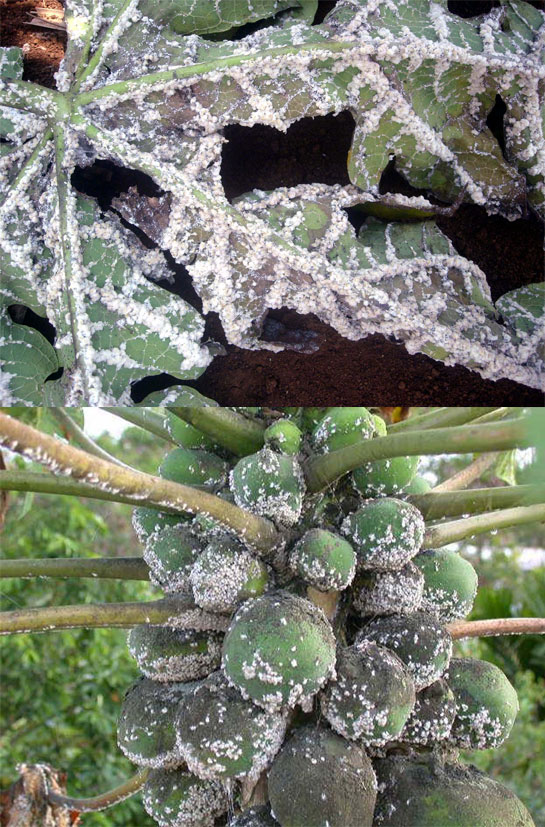Invasive papaya pest discovered by Virginia Tech team in Asia

Thanks to efforts by scientists in a Virginia Tech-led program, the papaya mealybug -- an emerging threat from India to Indonesia --is being identified and contained.
In May, 2008, a team from the Integrated Pest Management Collaborative Research Support Program (IPM CRSP), managed by Virginia Tech’s Office of International Research, Education, and Development in the Division of Outreach and International Affairs, identified papaya mealybug on papaya trees at the Bogor Botanical Gardens in West Java, Indonesia.
The IPM CRSP, funded by the U.S. Agency for International Development, is a consortium of integrated pest management scientists working to raise the standard of living in developing countries.
The scientists collected samples at Bogor and sent them for identification to a specialist in mealybug taxonomy at the California Department of Agriculture, who confirmed the identification as papaya mealybug — an unarmored scale insect found in moist, warm climates. It was the first reported occurrence of papaya mealybug in Indonesia and Southeast Asia.
Two months later, on a trip to Tamil Nadu Agricultural University in Coimbatore, India, Muni Muniappan, director of the IPM CRSP at Virginia Tech, recognized the telltale sticky residue on papayas he saw there as papaya mealybug.
In each case, IPM scientists alerted government authorities and advised them on appropriate actions to take. These discoveries are crucial; the sooner authorities can arrest the spread of the papaya mealybug, the better their chances of saving this lucrative tropical crop.
While papaya is an exotic fruit for us in the northern hemisphere, it is one that many of us use unknowingly in a variety of ways every day. Papain, a product of papaya, is used in the production of chewing gum, shampoo, and toothpaste and tooth whiteners; as a meat tenderizer; and in the brewing and textile industries. In many tropical countries, papaya is an important commercial crop and a key component of the daily diet.
For this reason, attacks by the papaya mealybug are a serious threat. In Indonesia, India, countries in the Caribbean and South America, the Hawaiian Islands, and Florida, papaya means millions of dollars for farmers, middlemen, and processors. In West Java, the scourge has wiped out most of the papaya plantations.
The papaya mealybug originated in Mexico, where it developed alongside natural enemies and was first identified in 1992. It wasn’t until it jumped countries and started proliferating in places where it had no natural enemies that it began to pose problems. In 1995, it was discovered on the Caribbean island of St. Martin. By the year 2000, it had spread to 13 countries in the Caribbean, to Florida in the United States, and to three countries each in Central and South America.
The papaya mealybug is a particularly devastating pest because it is polyphagous—it feeds on many things. The insect’s host range includes over 60 species of plants: cassava, papaya, beans, eggplant, melons, hibiscus, plumeria, pepper, sweet potato, tomato, citrus, mango and sour sop.
On papaya plants, the mealybug infests all parts of the young leaves and fruits, mostly along the veins and midrib of the older leaves. Young leaves become crinkly and older leaves turn yellow and dry up. Terminal shoots become bunchy and distorted. Affected trees drop flowers and fruits. To add insult to injury, the mealybug secretes a honeydew-like substance that turns into a thick sooty mold growth, making the fruit inedible and unusable for the production of papain.
The good news is that the U.S. Department of Agriculture’s Animal and Plant Health Inspection Service (APHIS) has developed a biological control program to tackle the pest. Biological control is an integrated pest management tactic that pits natural enemies against pests. APHIS has identified three parasitoids including parasitic wasps that are highly effective at containing the mealybug. These natural enemies are being cultured in a laboratory in Puerto Rico and are offered free to countries that request them.
The IPM CRSP team that traveled to Indonesia included Robert Hedlund, Cognizant Technical Officer for the USAID-funded program; Muniappan; Clemson University professors of entomology Merle Shepard and Gerry Carner; Clemson professor of economics Mike Hammig; Yulu Xia, assistant director of the NSF Center for IPM at North Carolina State; and Aunu Rauf, professor of entomology at Bogor Agricultural University in Indonesia.
While the challenge of reclaiming the papaya plantations from the papaya mealybug seems daunting, Muniappan is optimistic. “The use of parasitoids has been very effective in Caribbean and Latin American countries, and in Florida, Guam, and Palau,” he says. “But we need to be vigilant.”



.jpg.transform/m-medium/image.jpg)
